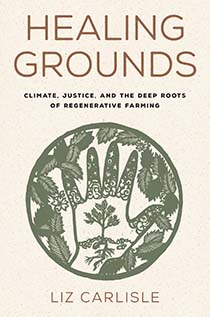
Climate, Justice, and the Deep Roots of Regenerative Farming”
By Liz Carlisle
Island Press, 2022
200 pages, hardcover, $28
Liz Carlisle could have written a book on regenerative agriculture that extolled the virtues of intensive grazing and no-till. She could have focused on practices like cover cropping and polyculture, and how they can lead to carbon sequestration and increased soil organic matter. That was her intent, after all: “to pin down the potential for agricultural climate solutions in technical terms.”
Thankfully for the reader, she ventures much deeper, positing: “Maybe we could actually make a dent in climate change if we tweaked more than just individual agricultural practices, if we reoriented the logic underpinning our entire food system.”
Over the course of four chapters, “Healing Grounds” leads us into the histories and present day of Indigenous, Black, Mesoamerican and Asian American farmers. From the Blackfeet Nation and a project to reintroduce buffalo to their native grazing grounds, to Black agroforestry in North Carolina, to the immense biodiversity and a community approach to small farming in California, readers are taken on a journey that acknowledges the effect of colonization on the land, people and climate, and are shown why we can’t settle for a simplistic approach of swapping a handful of conventional farming practices for regenerative ones.
From the buffalo, we learn how the fundamental principle of regenerative grazing is “one that challenges settler agriculture to its core.” Carlisle writes, “To see plants and animals as gifts, and indeed as teachers, we have to let go of the idea of domination … The most sustainable food systems, as the history of the North American prairie clearly demonstrates, are liberated ones.”
Each farmer Carlisle meets reiterates the importance of liberation. Even the language we use matters. Farmer Olivia Watkins prefers the term “spawn run” over “colonize” when talking about growing mushrooms. “Colonization connotes violence, and that’s not how mycelia — strands of fungi that collaborate to form a sort of superorganism — operate.”
Extracting the violence from our language requires understanding how violence has shaped farming, land and who has access to land in this country. Carlisle deftly weaves the histories of colonization, land theft, slavery, anti-Asian laws, and prejudice against immigrant farm workers alongside the concurrent histories of resilience, community, wisdom and skill of historically marginalized peoples. Where others may miss or dismiss the connections, Carlisle brings them to the forefront for us to grapple with.
“The structure and conditions of work are seldom raised in discussions about how to store more carbon in soils, but the two issues are powerfully connected. In our current food system, the exploitation of people and the exploitation of land are inextricably joined together. Our future food system must be one of mutual flourishing,” she writes.
This book doesn’t give us a straightforward strategy for carbon sequestration, but it does present answers in its own way — if we’re willing to honestly reckon with the history of colonization and afford land access to those most equipped to show us the way forward, then the possibility of healing soils, climate and communities is possible.
Katie Spring, Good Heart Farmstead, L3C, Worcester, Vermont
